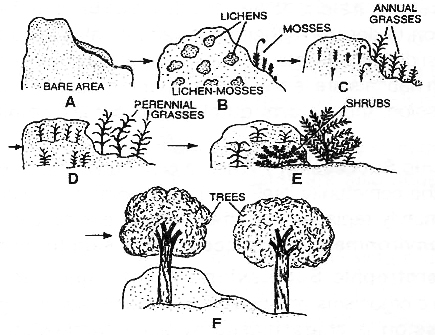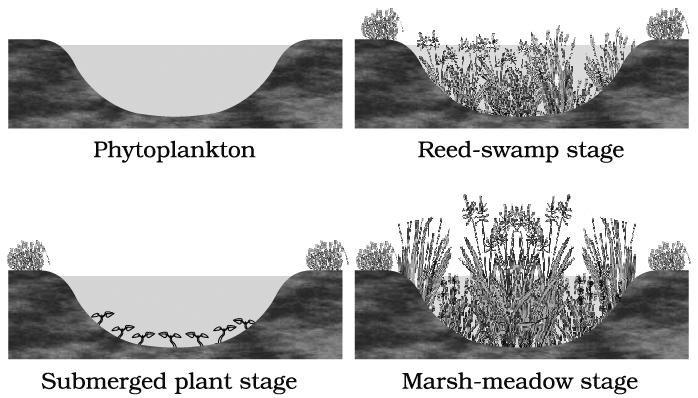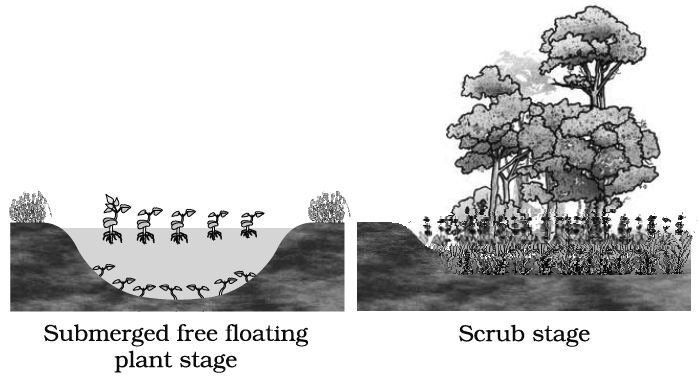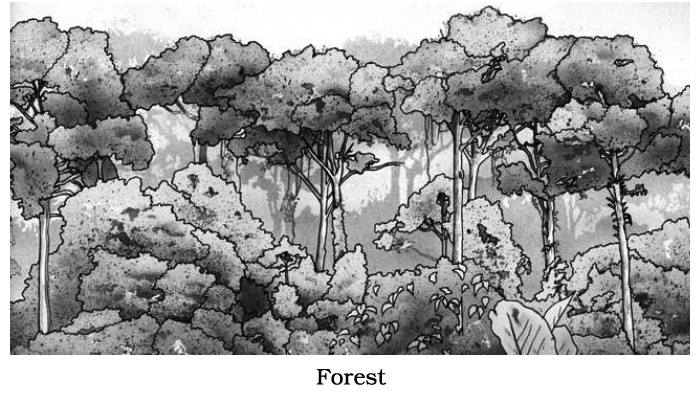- Books Name
- A TEXT OF BIOLOGY - CLASS XII
- Publication
- ACME SMART PUBLICATION
- Course
- CBSE Class 12
- Subject
- Biology
ECOLOGICAL SUCCESSION (BY HULT)
Biotic community is seldom static.
Its composition changes with time due to interactions between biotic and abiotic components.
This change is orderly and sequential, parallel with the changes in the physical environment.
These changes lead finally to a community that is in near equilibrium with the environment and is called climax community.
Such gradual and fairly predictable changes in the species composition of a given area are collectively called ecological succession.
During succession, some species colonise an area and their populations become more numerous, whereas populations of other species decline and even disappear.
The first biotic community that develops in a bare area is termed as pioneer community, e.g., lichens on bare rock.
The pioneer community is followed by a specific orderly sequence of series of plant communities called transitional communities or seral communities.
The entire series of communities is known as sere.
The last community in biotic succession which is relatively stable and in harmony with environment of that area is termed' as climax community.
It is also called as climatic climax.
All successional processes leads to a similar mesic climax.
Succession is hence a process that starts where no living organisms are there.
Types of Biotic Succession
(A) Depending upon the nature of habitat of its start, it is of two types, i.e., xerosere, starting on terrestrial habitat and hydrosere, starting on aquatic habitat. Xerosere is further of different types, i.e., lithoserestarting on barren rock and psammosere-starting on sand, halosere-in salt marshes (i.e., in a physiologically dry soil).
(B) Depending upon the type of nudity of the area, it is of two types:
(i) Primary succession. It starts at barren area, never having vegetation of any type. Cooled volcanic lava, sand dunes, igneous rocks, newly exposed sea or newly submerged terrestrial habitats in water, etc., are the areas where primary succession starts. It is very difficult for the pioneer community to get established in these areas and thus it takes a very long time.
(ii) Secondary succession. It starts at the habitats which become barren secondarily by the destruction of earlier vegetation under the influence of natural calamaties like forest fire, volcanic eruptions, earthquakes, landslides, floods, etc., or due to overgrazing and leaving the crop fields uncultivated for a long period. Such habitats are fertile, rich in organic matter and even occupied by certain organisms. Secondary succession, thus, starts quickly and climax community is established in a short span.
(C) Autogenic and Allogenic Succession : When a community replaces the other due to the modification of the environment by the community itself (internal factors) the succession is called autogenic. On the contrary, when a community replaces the other, largely due to the forces other than the effects of communities on the environment, the succession is said to be allogenic.
(D) Autotrophic and Heterotrophic Succession : Autotrophic succession is characterised by early dominance of autotrophic organisms and begins in predominantly inorganic environment. On the contrary, heterotrophic succession is characterised by early dominance of heterotrophs and begins in a predominantly organic environment.
Process of Succession
Major steps in a primary autotrophic succession are as follows :
1. Nudation: Exposure of an area.
2. Migration: The process of dispersal of seeds, spores and other structure of propagation of the species to bare area is known as migration.
3. Germination: It occurs when conditions are favourable.
4. Ecesis: Successful germination of propagules and its establishment in a bare area is known as ecesis.
5. Colonisation and Aggregation: After ecesis, the individuals of the species increase in number as the result of reproduction.
6. Competition and Co-action : Due to limited resources, species show both inter and intraspecific competition. This results into elimination of unsuitable and weaker plants.
7. Invasion: Various other types of plants try to establish in the spaces left by the elimination of previous plants due to competition.
8. Reaction: The newly arrived plants interrupt with the existing ones. As the result of reaction, environment is modified and becomes unsuitable for the existing community which sooner or later is replaced by another community.
9. Stabilisation: The process when the final climax community becomes more or less stabilised for a longer period of time and it can maintain itself in equilibrium with the climate of the area. As compared to transitional communities, the climax community has larger size of individuals, complex organization, complex food chains and food webs, more efficient energy use and more nutrient conservation.
Succession on bare rock
Succession starting on bare rock is termed lithosere. The various seral stage in lithosere are as follows.
1. Lichen stage.
The pioneer lichens on such habitats are usually crustose lichens, e.g., Graphis, Rhizocarpon.
The propagules of these lichens settle and get established on wet rock surface soon after rainfall.
They can tolerate desiccation and high temperature.
The acidic substance produced by lichens corrodes the rock surface forming small depressions and release minerals needed for the growth of lichens.
The dead and decaying organic matter of the lichens along with sand particles, brought by wind, to get collected in depressions and forms a little bit of soil by mixing with weathered rock particles.
The habitat becomes suitable for foliose lichens like Parmelia.
Foliose lichens compete with crustose lichens and slowly replace the latter due to their larger size.
They increase shading of rocks, more accumulation of organic matter and formation of larger depressions.
This accelerates the process of soil formation and makes the habitat more suitable for next seral stage, the moss stage.
2. Moss stage.
Due to interaction of foliose lichens, the habitat becomes suitable for hardy mosses (e.g., Tortula, Grimmia) to grow.
Mosses, being larger in size and having gregarious habit, shade the lichens and replace them.
Their rhizoids can penetrate deeper.
Growth of mosses leads to accumulation of more soil and organic matter which can retain moisture for a longer span and soon the habitat is occupied by moisture loving mosses (e.g., Hypnum, Bryum).

2. Annual grass stage.
During rainy season, the compact mat formed by mosses on weathered rock retain sufficient moisture and the habitat thus becomes suitable for germination of seeds of annual grasses and hardy herbs, e.g., Aristida, Poa, Eleusine, etc.
Their roots penetrate deeper and cause more weathering of rocks.
They replace mosses, grow for a couple of months and their death and decay results in increased organic matter.
This mixes with weathered rock particles to form soil and thus process of soil formation continues.
3. Perennial grass stage.
Due to increasing moisture and soil in rock crevices, annual grasses are replaced by perennial grasses.
These grasses like Heteropogon, Cymbopogon, etc., spread very fast due to the presence of runners and rhizomes.
4. Shrub stage.
The habitat occupied by perennial grasses soon become suitable for invasion of xerophytic shrubs like Zizyphus, Rubus, Rhus, Capparis,etc.
These shrubs soon get established in such habitats, replacing the perennial grasses.
As shrubs are larger in size, their roots penetrate deeper, causing more fragmentation of rock and hence more accumulation of soil.
5. Climax stage.
Shrubs are soon replaced by hardy trees.
Soon the atmosphere becomes more moist due to large amount of water transpired by large sized plants and ultimately the community, which is relatively more stable, occupies the habitat.
This is termed climax community.
The nature of climax community is determined by the climate of that area.
Succession in aquatic habitat
The succession starting in aquatic habitat like freshly formed pond is termed hydrosere.
The various seral stages are as follows:
1. Plankton stage.
The pioneers of hydrosere are the phytoplanktons, the minute microscopic autotrophic organisms like diatoms, unicellular, colonial or filamentous green algae and blue green algae (cyanobacteria).
The spores of these organisms reach the newiy formed pond through wind or animals.
They multiply rapidly.
The pond water containing large number of phytoplanktons becomes suitable habitat for zooplanktons which feed upon phytoplanktons, thus maintaining the balance.
The organic matter formed by death and decay of planktons, particulary zooplanktons mixes with clay and silt at the bottom of pond to form soft mud.
The habitat becomes suitable for the growth of next stage.
2. Submerged stage.
With the formation of soft mud at the bottom of pond, the habitat becomes suitable for the growth of anchored and submerged plants like Hydrilla, Najas, Potamogeton, etc.
They are anchored in mud and form dense growth.
More silt gets deposited around plants.
The accumulated silt along with decomposition of organic matter formed by decay of submerged plants makes the substrate fertile and raises the bottom level.
3. Floating stage.
In the pond, where the water becomes shallow, anchored plants with leaves floating (e.g., Nelumbo, Nuphar, Nymphaea), start growing and replace the plants of submerged stage which migrate to deeper waters in a pond.
These plants have subterranean stems like rhizomes and corms.
With the growth of these plants, water becomes richer in minerals and organic matter and the habitat becomes suitable for free floating plants like Lemna,Azolla, Spirodela, Wolffia, Eichhornia, etc.
The bottom level is further raised due to growth of free floating plants and accumulation of dead and decaying remains of these plants.
Water becomes much shallower at the periphery of pond.
It becomes almost a marshy habitat.
4. Reed swamp stage.
The periphery of the pond, where the water is very shallow due to interaction of free floating stage, becomes suitable for the growth of amphibious plants like Typha, Sagittaria, Phragmites, Scirpus etc.
These plants lose large quantity of water during transpiration and produce large amount of organic matter.
5. Sedge or marsh meadow stage.
The peripheral area of pond built up by plants of reed swamp stage is invaded by Cyperus, Carex (Sedge), Juncus and grasses like Themeda and Dichanthium and herbs like Campanula, Caltha, Polygonum, etc.
6. Scrub/Woodland stage.
The peripheral area of the pond occupied by marsh meadow stage is invaded by shrubs which can grow in water-logged soil and tolerate bright sunlight e.g., Cornus (Dogwood), Cephalanthus (button brush).
This further invite invasion of trees capable of bearing bright sunlight and water logging e.g., Populus (cottonwood), Alnus (Alder).



7. Climax Forest.
The woodland stage trees are replaced by new trees which grow to greater heights.
The nature of climax community is determined by climate, e.g., rain forest in moist tropical area and mixed coniferous or deciduous forest in temperate area.
Mixed tropical forest include trees like Quercus (oak), Ulmus (elm), Acer (maple) and gymnosperms like Abies (fir), Taxus (yew) and Picea (spruce).
Major trends during ecological succession
The major structural and functional attributes of ecological succession are:
(i) Increase in species diversity.
(ii) Increase in structural complexity.
(iii) Increase in organic matter.
(iv) Decrease in net community production.
(v) Food chain relationship becomes complex.
(vi) Niche become specific and narrower.
(vii) Stability increases.
(viii) More immobilization of nutrients (mineral nutrients fixed in biota).
(ix) Increased energy efficiency

 ACME SMART PUBLICATION
ACME SMART PUBLICATION
